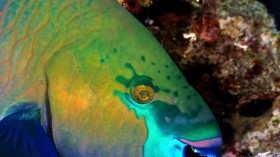Bruno Díaz López, a behavior ecologist and director of Bottlenose Dolphin Research Institute in Pontevedra, Spain, studied bottlenose dolphins at the Gulf of Aranci in Italy. With the use of photo-identification surveys, he studied the reactions of 24 dolphins between the years 2004 & 2011. He introduced the dolphins to various things such as a loud noisemaker or scuba diver and found that the individual dolphins had varied but consistent reactions.
Some of the mammals display bold behavior, quickly approaching the noisemaker or the person, while others are shy, avoiding the intruder. The rest of the animals had varying reactions within the two extremes.
Díaz López told Virginia Morell of the National Geographic that from studies in captivity, scientists know that dolphins possess personalities; however, the conditions in which they are staying are not their normal living conditions. Now, he says, they know that wild dolphins possess personalities, and these traits have an essential role to play in the animals' social system, just as they do in humans'.
His research was published in the Animal Behavior journal, contributing to our knowledge of dolphin behavior. We know that cetaceans have social groups that vary in size over time, with members leaving or joining. These are called "fission-fusion" social groups.
Past research shows the incredible complexity of the dolphins' social groups, which is similar to ours in some ways. A recent study showed pairs of males traveling together and singing in sync to attract females. Past studies have also demonstrated dolphins calling each other by individual names, and that they also grieve for dead dolphins.
Morigenos-Slovenian Mammal Society researchers found in 2018 how dolphin groups near the Slovenian coast in the northern Adriatic have strategies for avoiding each other while also sharing a favored feeding area each day. The study observed two groups of dolphins that had core "cliques" only seen together on four occasions in 16 years. Those outside this core are the "tiered" group, ranked according to the frequency of their interaction with the group. Then there are the lonely stragglers with no bonds to either of the groups.
The new study studied each dolphin to see how their personality influences the dynamic of the group. Díaz López mapped the relationships within the group, showing males and females being bold and shy in comparable proportions. The bold ones seem to have favorites, with preferences for particular companions. Díaz López states that the bold dolphins may be the ones who spread information within the group because of how they enjoy other dolphins' company.
Orr Spiegel, a behavioral ecologist at Tel Aviv University, says that the study must be commended for demonstrating such expected links in life, as the data is very challenging to collect. He was not involved in the study. However, Sasha Dall, a behavioral ecologist at the University of Exeter, says that it does not address the urgent question of the evolutionary advantage brought about by dolphin personality.
Díaz López intended the noisemaker in his study to keep the dolphins away from fishing nets and prevent them from getting the fishermen's catch. They were also meant to save dolphins from being caught in the nets. Díaz López, however, said that the noisemaker might be more harmful than beneficial, not only because they introduce noise pollution, but also because they inadvertently train dolphins to see them as a signal for dinner.
Once the bold dolphin figures this out, it could tell its friends.
© 2024 NatureWorldNews.com All rights reserved. Do not reproduce without permission.





